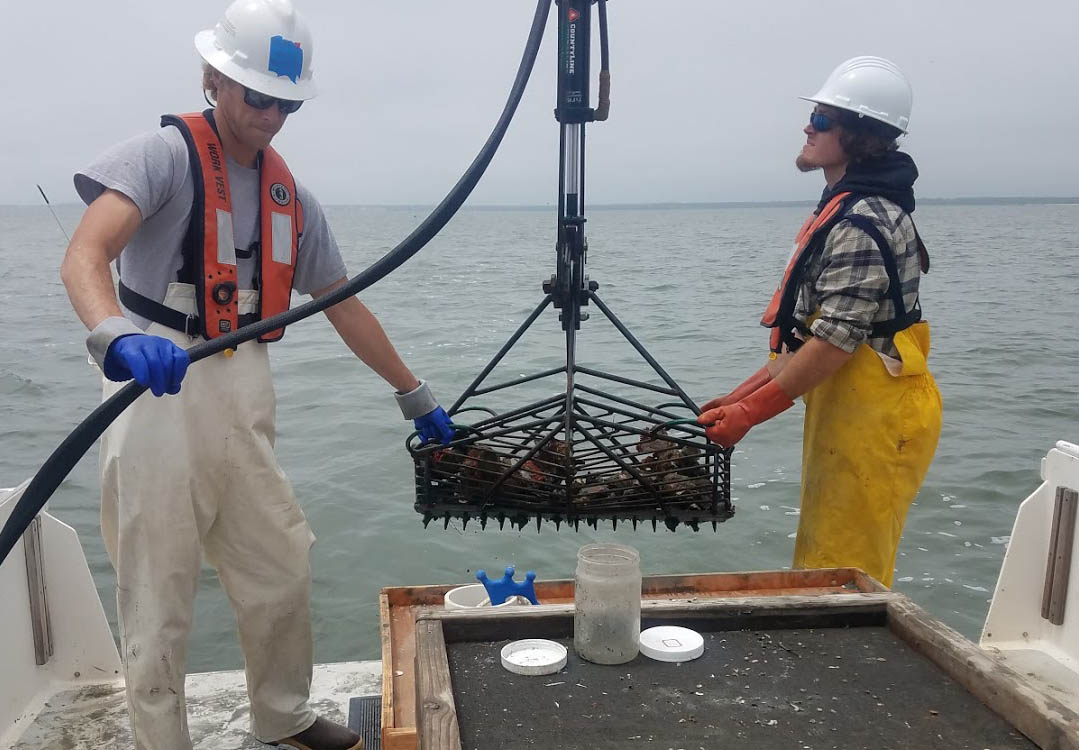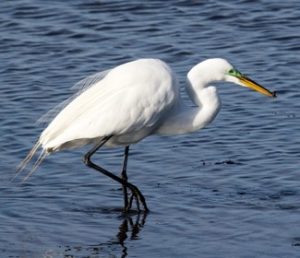Article by Christine Thompson, Assistant Professor of Marine Science, Stockton University.
A foggy day in late May brought my team of staff and students from Stockton University to sample oysters on our research lease in southern Barnegat Bay (which we call the“Tuckerton Reef”). This is part of routine sampling we do on the reef each spring. A second grant from the Barnegat Bay Partnership gives this project new life — after three years of planting shell on the reef, this summer we will go from one to two acres and more than double the amount of shell that was placed on this reef since the beginning of this project. (Read more about the initial project here.)
Oysters were planted on this site in 2016 and 2017. They were first reared in tanks where larvae were placed onto clean whelk or oyster shell and after a few weeks were brought to the restoration reef in Barnegat Bay. We also transplanted some oyster seed from a site in the Mullica River. After almost three years, the oysters are still going strong.

Benchmarks for successful oyster reefs have suggested there needs to be at least 15 oysters per square meter to have a functional oyster reef — our samples averaged 27 oysters per square meter. The average size of these oysters is over 4 inches — this means that each oyster can filter more than 50 gallons of water a day, which is over one-thousand gallons per square meter! This volume of water is equivalent to running a garden hose for one hour.
Although we have been monitoring this reef for almost three years, this year we are trying to implement some new methods for sampling them. Patent tongs are like giant (and very heavy) forks we carefully deploy off the side of the boat. When they reach the bottom, they close, and should capture everything within a square meter of reef bottom. The tongs were pretty good at sampling the oysters that were growing on the whelk shell substrate, but they were less successful at pulling up the shell that was transplanted from the Mullica River. We are going to be doing some sonar work to look for this shell using sound waves on the bottom and figure out the best way to sample it.
The two main goals of this project are to document habitat creation and quantify the water filtration capability of the oysters on the reef. Throughout the summer we will be performing studies to assess fish and invertebrate use of the reef and collect more long-term water quality data so we can better understand the impacts these oysters are having on water filtration and nutrient removal.

As a biologist, I am most interested in the community of organisms that live around the oysters. This includes things like fish, crabs, and snails that live amongst the shells, and organisms that live on the surface of shells like sea squirts, sponges, and tiny moss animals called bryozoans. Each time we sample we find something new in our samples—like bay scallops, sea horses, or sea slugs. This time we found the coolest surprise so far—a hairy sea cucumber!

Without the oysters creating three-dimensional habitat, these organisms would be vulnerable to predators on the seafloor. Seeing the numbers of species increase each time we sample is proof of this habitat creation.
Stay tuned throughout the summer as I post updates on the different pieces of this project. In late June, we will do a live video cast from the site as we pull up samples and talk about the different species we find.
Special thanks to our partners in this project, Parsons Mariculture, Long Beach Township, and JettyRock Foundation which provide the oysters and shell for the reef. Learn more about the local shell recycling program here.
Author contact: Christine.Thompson@stockton.edu


